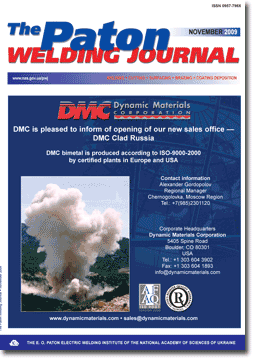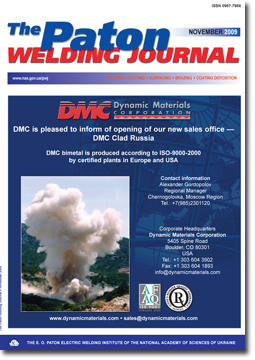Access for download PDF files for subscribers and for reviewers of scientometric bases.
Organization: Elsevier for content access(PDF files of journals released before 2024 are available for download from the website's archives))
Organization: Elsevier for content access(PDF files of journals released before 2024 are available for download from the website's archives))
| 2009 №11 (07) | 2009 №11 (09) |

TPWJ, 2009, #11, 39-41 pages
DETERMINATION OF THE PARAMETERS OF SHOCK-COMPRESSED GAS IN THE WELDING GAP AHEAD OF THE CONTACT POINT IN EXPLOSION CLADDING
Journal The Paton Welding Journal
Publisher International Association «Welding»
ISSN 0957-798X (print)
Issue № 11, 2009 (November)
Pages 39-41
Authors
S.Yu. BONDARENKO1, D.V. RIKHTER2, O.L. PERVUKHINA2 and L.B. Pervukhin2
1Altai State Agricultral University, Barnaul, RF
2Institute of Structural Macrokinetics and Materials Science, RAS, Chernogolovka, RF
Abstract
Dynamics of formation of shock-compressed gas region is considered, and dependence of the maximum length of the compressed-gas region on the contact point velocity and plate length has been derived. A hypothesis is offered that thermal ionization of gas to form thin layers of low-temperature plasma takes place at the interface in the welding gap ahead of the contact point in the supersonic flow (5-6 Mach) of the shock-compressed gas over the surfaces being welded.
Keywords: explosion cladding, gap between the plates, shock-compressed gas, gas parameters, thermal ionization of gas
Received: ??
Published: 28.11.09
References
1. Richter, U. (1973) Application of explosive-welded bimetals to constructing apparatuses for chemical industry. In: Proc. of 2nd Int. Conf. on Explosives (Marianske Lazne, CSSR, 1973), 253-261.
2. Kudinov, V.M., Koroteev, A.Ya. (1978) Explosion welding in metallurgy. Moscow: Metallurgiya.
3. Deribas, A.A., Zakharenko, I.D. (1975) On surface effects in glancing collisions of metal plates. Fizika Goreniya i Vzryva, 11(1), 151-153.
4. Berdychenko, A.A., Zlobin, B.S., Pervukhin, L.B. et al. (2003) About possible inflammation of particles propelled into the gap in explosion welding of titanium. Ibid., 39(2), 128-136.
5. Ishutkin, S.N., Kirko, V.I., Simonov, V.A. (1980) Investigation of heat effect of shock-compressed gas on colliding plate surface. Ibid., 16(6), 69-73.
6. Ashaev, V.K., Doronin, G.S., Ermolovich, E.I. et al. (2006) Application of explosion welding and heat treatment methods for manufacturing of multilayer armored compositions having higher bullet-proof and survivability. In: Transact, on Armament, Automation, Control. Kovrov.
7. Alekseev, Yu.L., Smirnova, G.M. (1994) Joint formation in explosion welding. Fizika i Khimiya Obrab. Metallov, 4/5, 126-130.
8. Alekseev, Yu.L., Smirnova, G.M. (1994) About conditions of explosion welded joint formation. Ibid., 2, 112-116.
9. Pervukhina, O.L., Berdychenko, A.A., Pervukhin, L.B. et al. (2006) Influence of atmosphere composition on formation of titanium-to-steel joint in explosion welding. In: Transact, on Higher Education Institutions on Explosion Welding and Properties of Welded Joints. Volgograd: VolgGTU, 59-64.
10. Zeldovich, Ya.B., Rajzer, Yu.P. (1966) Physics of shock waves and high-temperature hydrodynamic phenomena. Moscow: Nauka.
11. Frank-Kamenetsky, D.A. (1975) Plasma is the fourth state of matter. Moscow: Atomizdat.
Suggested Citation
S.Yu. BONDARENKO, D.V. RIKHTER, O.L. PERVUKHINA and L.B. Pervukhin (2009) DETERMINATION OF THE PARAMETERS OF SHOCK-COMPRESSED GAS IN THE WELDING GAP AHEAD OF THE CONTACT POINT IN EXPLOSION CLADDING. The Paton Welding J., 11, 39-41.The cost of subscription/purchase order journals or individual articles
| Journal/Currency | Annual Set | 1 issue printed |
1 issue |
one article |
| TPWJ/USD | 384 $ | 32 $ | 26 $ | 13 $ |
| TPWJ/EUR | 348 € | 29 € | 24 € | 12 € |
| TPWJ/UAH | 7200 UAH | 600 UAH | 600 UAH | 280 UAH |
| AS/UAH | 1800 UAH | 300 UAH | 300 UAH | 150 UAH |
| AS/USD | 192 $ | 32 $ | 26 $ | 13 $ |
| AS/EUR | 180 € | 30 € | 25 € | 12 € |
| SEM/UAH | 1200 UAH | 300 UAH | 300 UAH | 150 UAH |
| SEM/USD | 128 $ | 32 $ | 26 $ | 13 $ |
| SEM/EUR | 120 € | 30 € | 25 € | 12 € |
| TDNK/UAH | 1200 UAH | 300 UAH | 300 UAH | 150 UAH |
| TDNK/USD | 128 $ | 32 $ | 26 $ | 13 $ |
| TDNK/EUR | 120 € | 30 € | 25 € | 15 € |
AS = «Automatic Welding» - 6 issues per year;
TPWJ = «PATON WELDING JOURNAL» - 12 issues per year;
SEM = «Electrometallurgy Today» - 4 issues per year;
TDNK = «Technical Diagnostics and Non-Destructive Testing» - 4 issues per year.


